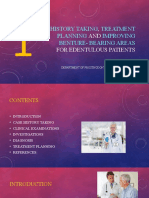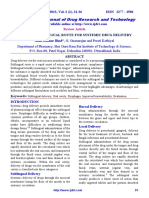0 ratings0% found this document useful (0 votes)
29 viewsNutrition in Human Beings
Nutrition in Human Beings
Uploaded by
parashakthi PRThe document discusses the human digestive system, including the mouth, esophagus, stomach, small intestine, large intestine and associated glands. It describes the structure and function of each part as well as the digestion and absorption processes.
Copyright:
© All Rights Reserved
Available Formats
Download as DOCX, PDF, TXT or read online from Scribd
Nutrition in Human Beings
Nutrition in Human Beings
Uploaded by
parashakthi PR0 ratings0% found this document useful (0 votes)
29 views8 pagesThe document discusses the human digestive system, including the mouth, esophagus, stomach, small intestine, large intestine and associated glands. It describes the structure and function of each part as well as the digestion and absorption processes.
Copyright
© © All Rights Reserved
Available Formats
DOCX, PDF, TXT or read online from Scribd
Share this document
Did you find this document useful?
Is this content inappropriate?
The document discusses the human digestive system, including the mouth, esophagus, stomach, small intestine, large intestine and associated glands. It describes the structure and function of each part as well as the digestion and absorption processes.
Copyright:
© All Rights Reserved
Available Formats
Download as DOCX, PDF, TXT or read online from Scribd
Download as docx, pdf, or txt
0 ratings0% found this document useful (0 votes)
29 views8 pagesNutrition in Human Beings
Nutrition in Human Beings
Uploaded by
parashakthi PRThe document discusses the human digestive system, including the mouth, esophagus, stomach, small intestine, large intestine and associated glands. It describes the structure and function of each part as well as the digestion and absorption processes.
Copyright:
© All Rights Reserved
Available Formats
Download as DOCX, PDF, TXT or read online from Scribd
Download as docx, pdf, or txt
You are on page 1of 8
Nutrition in Human Beings – Life Processes Class
10 Notes
Human beings are complex animals, which have a
complex digestive system. The human digestive
system is composed of an alimentary canal and some
accessory glands. The alimentary canal is divided
into several parts, like oesophagus, stomach, small
intestine, large intestine, rectum and anus. Salivary
gland, liver and pancreas are the accessory glands
which lie outside the alimentary canal.
Structure of the Human Digestive System:
The human digestive system comprises of the
alimentary canal and associated digestive glands.
Alimentary Canal: It comprises of mouth,
oesophagus, stomach, small intestine and
large intestine.
Associated Glands: Main associated glands
are
o Salivary gland
o Gastric Glands
o Liver
o Pancreas
Mouth or Buccal Cavity:
The mouth has teeth and tongue. Salivary
glands are also present in the mouth.
The tongue has gustatory receptors which
perceive the sense of taste.
The tongue helps in turning over the food so
that saliva can be properly mixed in it.
Teeth help in breaking down the food into
smaller particles so that, swallowing of food
becomes easier.
There are four types of teeth in human
beings. The incisor teeth are used for cutting
the food.
The canine teeth are used for tearing the food
and for cracking hard substances.
The premolars are used for the coarse
grinding of food. The molars are used for
fine grinding of food.
Salivary glands secrete saliva: Saliva makes the
food slippery which makes it easy to swallow the
food. Saliva also contains the enzyme salivary
amylase or ptyalin. Salivary amylase digests starch
and converts it into sucrose, (maltose).
Oesophagus: Taking food from mouth to stomach
by Peristaltic movement.
Peristaltic movement: Rhythmic contraction of
muscles of the lining of the alimentary canal to push
the food forward.
Stomach
Stomach is a bag-like organ. Highly
muscular walls of the stomach help in
churning the food.
The walls of the stomach secrete
hydrochloric acid. Hydrochloric acid kills the
germs which may be present in food.
Moreover, it makes the medium inside the
stomach as acidic. The acidic medium is
necessary for gastric enzymes to work.
The enzyme pepsin, secreted in the stomach,
does partial digestion of protein.
The mucus, secreted by the walls of the
stomach saves the inner lining of the stomach
from getting damaged from hydrochloric
acid.
Small Intestine: It is a highly coiled tube-like
structure. The small intestine is longer than the large
intestine but its lumen is smaller than that of the
large intestine. The small intestine is divided into
three parts, like duodenum, jejunum and ileum.
Liver: Liver is the largest organ in the human body.
The liver manufactures bile, which gets stored in the
gall bladder. From the gall bladder, bile is released
as and when required.
Pancreas: Pancreas is situated below the stomach. It
secretes pancreatic juice which contains many
digestive enzymes.
Bile and pancreatic juice go to the duodenum
through a hepatopancreatic duct. Bile breaks down
fat into smaller particles. This process is called
emulsification of fat. After that, the enzyme lipase
digests fat into fatty acids and glycerol. Trypsin and
chymotrypsin are enzymes which digest protein into
amino acids. Complex carbohydrates are digested
into glucose. The major part of digestion takes place
in the duodenum.
No digestion takes place in the jejunum: The inner
wall in the ileum is projected into numerous finger-
like structures, called villi. Villi increase the surface
area inside the ileum so that optimum absorption can
take place. Moreover, villi also reduce the lumen of
the ileum so that food can stay for a longer duration
in it, for optimum absorption. Digested food is
absorbed by villi.
Large Intestine:
Large intestine is smaller than the small
intestine.
Undigested food goes into the large intestine.
Some water and salt are absorbed by the
walls of the large intestine. After that, the
undigested food goes to the rectum, from
where it is expelled out through the anus.
Large Intestine bbsorb excess of water. The
rest of the material is removed from the body
via the anus. (Egestion).
You might also like
- Bad+Breath+Gone+-+One+Day+Detox (2022 - 08 - 12 20 - 39 - 38 UTC)Document33 pagesBad+Breath+Gone+-+One+Day+Detox (2022 - 08 - 12 20 - 39 - 38 UTC)giovannismNo ratings yet
- Equine Applied and Clinical Nutrition (VetBooks - Ir)Document673 pagesEquine Applied and Clinical Nutrition (VetBooks - Ir)Lu MarfiaNo ratings yet
- Science Project - Digestive SystemDocument28 pagesScience Project - Digestive Systemapi-35222133567% (18)
- IB 1108 L08 EnzymesDocument5 pagesIB 1108 L08 EnzymesT CaffeeNo ratings yet
- A Journey through the Digestive System with Max Axiom, Super Scientist: 4D An Augmented Reading Science ExperienceFrom EverandA Journey through the Digestive System with Max Axiom, Super Scientist: 4D An Augmented Reading Science ExperienceNo ratings yet
- Digestive SystemDocument7 pagesDigestive SystemChristine Joyce S. CruzNo ratings yet
- Grade 8 Digestive SystemDocument28 pagesGrade 8 Digestive SystemKryssia Dema-alaNo ratings yet
- Overview of The Digestive SystemDocument9 pagesOverview of The Digestive SystemMehmet SaylıkNo ratings yet
- Shakila Hamed Report PDFDocument9 pagesShakila Hamed Report PDFShakila HamidNo ratings yet
- Nutrition in Human Beings Class 6Document5 pagesNutrition in Human Beings Class 6Sarada KasyapNo ratings yet
- Anatomy and Physiolog AMOEBIASISDocument9 pagesAnatomy and Physiolog AMOEBIASISSamer SumalinogNo ratings yet
- Digestive SystemDocument25 pagesDigestive Systembazaar9No ratings yet
- Mouth: Oral CavityDocument6 pagesMouth: Oral CavityMaria Teresa Casili - PerezNo ratings yet
- Digestive SystemDocument4 pagesDigestive Systemsikandercheema123No ratings yet
- Full Digestive System DescriptionDocument5 pagesFull Digestive System DescriptionmanuelaristotleNo ratings yet
- Essay # 4. DigeDocument9 pagesEssay # 4. DigeAbdul Karim BurkiNo ratings yet
- Digestive System Grade 10-11Document7 pagesDigestive System Grade 10-11Nandana Nayana KumaraNo ratings yet
- Life Processes (Digestion)Document1 pageLife Processes (Digestion)Farid AhemadNo ratings yet
- Digestive System AnatomyDocument11 pagesDigestive System AnatomyYeni Jesika SilitongaNo ratings yet
- Strategic Intervention Material: Dig Esti Ve Syst emDocument16 pagesStrategic Intervention Material: Dig Esti Ve Syst emKarla Javier PadinNo ratings yet
- Digestive SystemDocument41 pagesDigestive SystemAngelyn AbuevaNo ratings yet
- ACFrOgBAd0WeRD1vjWNtmCOlmKa8dDD4 OrOfgg 7yaz ufgakhcunueMb8rKkFL8MQy4yf3fYv LCC1Edl48oumKBcjVf2KicFMLTQQPJr7g2jQyTmLgkOMkp4wwDtAYx2cesqh8gZRTAXVq HTDocument10 pagesACFrOgBAd0WeRD1vjWNtmCOlmKa8dDD4 OrOfgg 7yaz ufgakhcunueMb8rKkFL8MQy4yf3fYv LCC1Edl48oumKBcjVf2KicFMLTQQPJr7g2jQyTmLgkOMkp4wwDtAYx2cesqh8gZRTAXVq HTLilyana DjunaidiNo ratings yet
- Digestion and AbsorptionDocument4 pagesDigestion and AbsorptionMin NimNo ratings yet
- Human Digestive System: by Ruhan Shukla Class 10 ADocument16 pagesHuman Digestive System: by Ruhan Shukla Class 10 ARuhan ShuklaNo ratings yet
- CP Dianne Ana PhysioDocument5 pagesCP Dianne Ana PhysioyangreinNo ratings yet
- Anatomy and Physiology of The Digestive System: Tongue MusclesDocument3 pagesAnatomy and Physiology of The Digestive System: Tongue Musclesbarbiegirl9497No ratings yet
- Biology NotesDocument18 pagesBiology NotesajairafingerishiNo ratings yet
- Anabolic Steroids & Growth Hormone 1 (PDFDrive)Document778 pagesAnabolic Steroids & Growth Hormone 1 (PDFDrive)Feifan LuNo ratings yet
- Handout - Chapter 3 - Digestion - Google Docs - 1665372467933 3Document8 pagesHandout - Chapter 3 - Digestion - Google Docs - 1665372467933 3NC ExistentialNo ratings yet
- Digestive SystemDocument36 pagesDigestive SystemSMIT BMENo ratings yet
- The Human Digestive SystemDocument10 pagesThe Human Digestive SystemAnurag TripathyNo ratings yet
- Anatomy and Physiology of The Digestive SystemDocument5 pagesAnatomy and Physiology of The Digestive SystemJesrel DelotaNo ratings yet
- Digestive System of HumansDocument13 pagesDigestive System of HumansNAMISH MAHAKULNo ratings yet
- Visible Body DigestiveDocument8 pagesVisible Body Digestivejellypish269No ratings yet
- Digestive System A&p BookletDocument11 pagesDigestive System A&p Bookletnurse1990No ratings yet
- Digestive System, Educational PlatformDocument77 pagesDigestive System, Educational Platformluckytraders0511No ratings yet
- NUTRITIONDocument11 pagesNUTRITIONRushana SadaqatNo ratings yet
- Digestive System Kel 1Document4 pagesDigestive System Kel 1Melia NurfadilaNo ratings yet
- 10 BiologyDocument3 pages10 BiologyNaveen NNo ratings yet
- Digestive System and Process of DigestionDocument4 pagesDigestive System and Process of DigestionSid QNo ratings yet
- Science PSLE PreparationsDocument45 pagesScience PSLE PreparationsRaghu Pavithara100% (1)
- Handout in Science 8: Biology LESSON 1: Organs of The Digestive SystemDocument5 pagesHandout in Science 8: Biology LESSON 1: Organs of The Digestive SystemJanna SarmientoNo ratings yet
- Science, CH 2 NUTRITION IN ANIMALSDocument25 pagesScience, CH 2 NUTRITION IN ANIMALSRaminder GhotraNo ratings yet
- Human Digestive SystemDocument11 pagesHuman Digestive SystemSyeda NafeezaNo ratings yet
- Human Digestive SystemDocument11 pagesHuman Digestive SystemSyeda NafeezaNo ratings yet
- BIO103 Lec-17.46 ArIm Digestive System 220424Document27 pagesBIO103 Lec-17.46 ArIm Digestive System 220424bilashqipNo ratings yet
- Group 1 Digestive System PDFDocument42 pagesGroup 1 Digestive System PDFBrenna Eilis AmadorNo ratings yet
- Digestive SystemDocument12 pagesDigestive Systemapi-269652707No ratings yet
- Digestive System Alimentary Tract of The Digestive System MouthDocument5 pagesDigestive System Alimentary Tract of The Digestive System MouthJoNo ratings yet
- Biology Sahil ArminDocument22 pagesBiology Sahil Arminarmin marandiNo ratings yet
- The Human Digestive SystemDocument37 pagesThe Human Digestive SystemEvangeline Basilan GarciaNo ratings yet
- UntitledDocument21 pagesUntitledRheanne SadiwaNo ratings yet
- The Human Digestive SystemDocument3 pagesThe Human Digestive SystemRaqeeb ul HaqNo ratings yet
- Digestive System ScriptDocument4 pagesDigestive System ScriptNEPERESM TALCEY BORCESNo ratings yet
- The Human Digestive SystemDocument12 pagesThe Human Digestive SystemmarwaNo ratings yet
- Teeth and Tongue-: I. MouthDocument11 pagesTeeth and Tongue-: I. Moutharisu100% (1)
- Clase 10-16-2015Document9 pagesClase 10-16-2015jv9937No ratings yet
- FenieDocument32 pagesFenieLilacx ButterflyNo ratings yet
- Digestive System WorksheetDocument4 pagesDigestive System WorksheetRussel GuratNo ratings yet
- PhotosynthesisDocument182 pagesPhotosynthesisparashakthi PRNo ratings yet
- OesophagusDocument21 pagesOesophagusparashakthi PRNo ratings yet
- Plasma MembraneDocument6 pagesPlasma Membraneparashakthi PRNo ratings yet
- CBQ - X - Biology, 2022-23Document10 pagesCBQ - X - Biology, 2022-23parashakthi PRNo ratings yet
- 10 Sci Life Process NotesDocument19 pages10 Sci Life Process Notesparashakthi PRNo ratings yet
- BIO270 LAB PRACTICAL 4 GORUP 5Document20 pagesBIO270 LAB PRACTICAL 4 GORUP 52023841734No ratings yet
- SALIVA As DNA'S SOURCEDocument23 pagesSALIVA As DNA'S SOURCEHillary Desiree RNo ratings yet
- Soal ExplanationDocument4 pagesSoal ExplanationYuliaNurIstiqomahNo ratings yet
- CBSE Class 10 Science Chapter 6 Life Processes NotesDocument43 pagesCBSE Class 10 Science Chapter 6 Life Processes NotesJapani TutorNo ratings yet
- Frazalni Glagoli - Vezbi 1Document4 pagesFrazalni Glagoli - Vezbi 1Valentina PrepaskovskaNo ratings yet
- Experiments 11 15 NotesDocument16 pagesExperiments 11 15 Notesforisko05No ratings yet
- Physiological Control and Mechanism of Salivation: DR Oyetola Elijah Senior Lecturer/Consultant Oral Medicine, OAU/OAUTHCDocument19 pagesPhysiological Control and Mechanism of Salivation: DR Oyetola Elijah Senior Lecturer/Consultant Oral Medicine, OAU/OAUTHCJoe AjibadeNo ratings yet
- The Mouth Starts Everything MovingDocument2 pagesThe Mouth Starts Everything MovingДария КоваленкоNo ratings yet
- Diet and Nutrition in Geriatric PatientsDocument38 pagesDiet and Nutrition in Geriatric PatientsDapinder BrarNo ratings yet
- VV Sub Dosha Poster WEB 2019Document1 pageVV Sub Dosha Poster WEB 2019Fabiana MitsikNo ratings yet
- MCQ RRB NTPC Biology PDFDocument3 pagesMCQ RRB NTPC Biology PDFSiddharth PradhanNo ratings yet
- Harsh Singh Chemistry3Document10 pagesHarsh Singh Chemistry3hateu1588No ratings yet
- History Taking, Treatment Planning 1Document117 pagesHistory Taking, Treatment Planning 1bhamaNo ratings yet
- Datafortress 2020 - Interlock Unlimited - Drug Lab UnlimitedDocument13 pagesDatafortress 2020 - Interlock Unlimited - Drug Lab UnlimitedSokoliak 010010110100% (1)
- Analysis of PCR Test SwabsDocument15 pagesAnalysis of PCR Test SwabsJohn KuhlesNo ratings yet
- Mohd Firdaus HowPhDThesisDocument371 pagesMohd Firdaus HowPhDThesisSyahmeer HowNo ratings yet
- Xerostomia PDFDocument7 pagesXerostomia PDFSak BolNo ratings yet
- MLT 1027 Learning Outcome 13 DigestiveDocument226 pagesMLT 1027 Learning Outcome 13 DigestiveMelanie TranNo ratings yet
- Nutrition (Digestive System)Document57 pagesNutrition (Digestive System)anglie feNo ratings yet
- NCERT - Exemplar - Life ProcessesDocument26 pagesNCERT - Exemplar - Life ProcessesRagini BaghelNo ratings yet
- A Review Sublingual Route For Systemic Drug DeliveryDocument6 pagesA Review Sublingual Route For Systemic Drug DeliveryPriambodo Gandhi100% (1)
- SALIVADocument68 pagesSALIVANimmi RenjithNo ratings yet
- Physiology of The Digestive System (GIT) : The Gastrointestinal System Carries Out The Following ActivitiesDocument53 pagesPhysiology of The Digestive System (GIT) : The Gastrointestinal System Carries Out The Following ActivitiesBelay MulugetaNo ratings yet
- Hare Krishna CookingDocument250 pagesHare Krishna CookingGuru Pg100% (4)
- Chapter 7 - The Digestive SystemDocument65 pagesChapter 7 - The Digestive SystemLama AlqarniNo ratings yet
- The Mouth and Buccal CavityDocument3 pagesThe Mouth and Buccal CavityRajeev VazhakkatNo ratings yet
- Simulated Body Fluids CompositionDocument14 pagesSimulated Body Fluids CompositionAnuj Sharma100% (1)






























































































